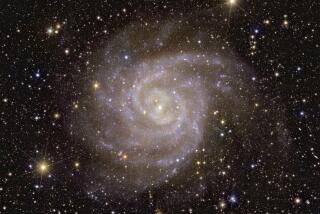Fixed Hubble’s Sharp Photos Cause Elation
- Share via
Ebullient astronomers released the first sharp, focused images from the refurbished Hubble Space Telescope on Thursday as evidence that the astronauts who carried out five days of dramatic spacewalks to repair the telescope last month had accomplished their goal.
The unprecedented detail in NASA photos of a spiral galaxy, a dense nursery of young stars and other distant celestial objects was proof that after three years of national ridicule and a costly repair mission, the orbital observatory is performing up to expectations.
“The trouble with Hubble is over,” said Sen. Barbara A. Mikulski, the Maryland Democrat who heads the Senate subcommittee responsible for financing the space agency.
Holding a photograph of the spiral galaxy over her head like a trophy, she said: “We will be able to do 21st Century science.”
NASA Administrator Daniel S. Goldin said the telescope’s performance exceeded the agency’s “wildest dreams.” Presidential science adviser John Gibbons, calling the repairs “a superb example of the new NASA,” made it clear that what the White House liked best about the rejuvenated telescope was that it had been fixed on time and within budget.
Launched three years ago, the Hubble Space Telescope was designed to see farther into the universe than any telescope ever built, using wavelengths blocked to astronomers on Earth. After it reached orbit, engineers determined that its primary mirror had been ground to the wrong prescription, a flaw that the manufacturer apparently had concealed from the space agency, according to congressional testimony.
During an 11-day shuttle mission last month, a crew of seven astronauts installed a set of corrective optics designed to compensate for the Hubble’s flawed mirror and also replaced the telescope’s workhorse wide-field camera with a more sophisticated set of four cameras built by the Jet Propulsion Laboratory in Pasadena.
NASA flight controllers have not deployed all of the telescope’s new instruments, but they said the new camera and corrective optics have been tested extensively since the repair mission and they are certain that the telescope is performing properly.
“For the first time,” senior JPL scientist John Trauger said, “we know we can begin doing the kind of science you can only do with a telescope like this above Earth’s atmosphere.”
During Hubble’s planned 15 years of operation, astronomers will scrutinize objects as close as asteroids, comets and planets within the solar system and as distant as quasars at the farthest and oldest reaches of the universe. More than 1,200 astronomers are scheduled to use the telescope this year.
Astronomers say the refocused Hubble will be able to provide final proof about the existence of black holes and, over the next three years, will allow them to calculate the true age of the universe. This spring, astronomers plan to use the Hubble to search for a black hole at the heart of galaxy M87.
Prior to a news conference Thursday, NASA officials treated Hubble’s “first light” pictures--the name given to an observatory’s initial photos--with the kind of secrecy usually associated with the rollout of a new car in Detroit.
Once the images were made public, agency officials in Washington and engineers at JPL could barely contain their elation, competing for superlatives to describe the new optics.
The corrected telescope, they said, was powerful enough to pick out a firefly 8,500 miles away; to see “with clarity” objects 12 billion light-years from Earth.
“These corrected images are as perfect as engineering can achieve and the laws of physics will allow,” said James H. Crocker, a Hubble scientist at the Space Telescope Science Institute at Johns Hopkins University in Baltimore.
The photos released Thursday were taken with the camera designed by JPL. They included:
* An image of Eta Carinae, one of the most massive and luminous stars in the night sky, surrounded by an expanding ruby red shell of high-speed stellar gases. The refurbished Hubble detected the structure of the material closest to the star--of intense interest to astronomers--for the first time.
* An image of the heart of a spiral galaxy called M100 in the Virgo cluster, showing that the telescope can resolve relatively small objects in a galaxy tens of millions of light-years away. The resolution is high enough to enable astronomers to make the crucial measurements necessary to gauge the size of the universe.
* An image of a star nursery inside a giant cloud of gas in a neighboring galaxy called the Large Magellanic Cloud, revealing more than 3,000 stars in its central star cluster. In earlier, blurred Hubble images, astronomers could discern only several hundred.
More to Read
Sign up for Essential California
The most important California stories and recommendations in your inbox every morning.
You may occasionally receive promotional content from the Los Angeles Times.













